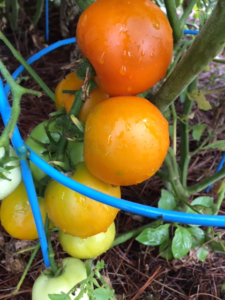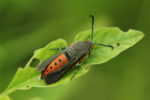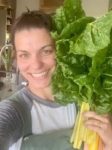
Juane Flamme Tomato
Austin’s May Vegetable Garden Checklist Tips from Paula Wolfel
May provides a window when a few more vegetables can be planted before the summer heat arrives, but is mainly a month when Austin gardeners tend to the plants that were put in the ground earlier in the spring and start harvesting. Many gardeners are harvesting beans, peas, tomatoes, squashes, radishes, carrots, lettuces, and squashes, to name a few. Unfortunately, also in May, insects and diseases are in full force. Pill bugs, tiger moth caterpillar and the saltmarsh caterpillars have been spotted in abundance in gardens causing destruction eating leaves. May is usually the month that the squash vine borer appears in the Austin gardens. Make sure you check your plants regularly.
Plant Highlight: Tomatoes
Tomatoes are a popular garden vegetable crop in Texas. Texas gardeners can grow a variety of small- and large-fruited tomatoes, as well as those used commonly for tomato paste and sauce. Tomato plants are either classified as determinate—reach a certain plant height and then stop growing; ideal for gardeners who want most of their tomatoes at once—or indeterminate—continue to grow and produce tomatoes throughout the growing season. When selecting varieties, choose the plant that best fits your garden space and your culinary needs.
Best Varieties for Central Texas
Small Fruit:
- Baxter’s Early Bush (Determinate)
- Black Cherry (Indeterminate)
- Cherry Grande (Determinate)
- Juliet (Indeterminate)
- Sun Gold (Indeterminate)
- Sweet Baby Girl (Indeterminate)
- Sweet 100 (Indeterminate)
- Yellow Pear (Indeterminate)
Large Fruit:
- Better Boy
- Big Beef (Indeterminate)
- Black Krim (Indeterminate)
- Celebrity (Semi-determinate)
- Cherokee Purple (Indeterminate)
- Early Girl (Indeterminate)
- Jaune Flamme (Indeterminate)
- Tycoon (Determinate)
- Stupice (Indeterminate)
Paste:
- Roma (Determinate)
- San Marzano (Indeterminate)
- Viva Italia (Determinate)
Planting and Caring for Tomatoes
When it comes to growing tomatoes in Central Texas, it is important to plant transplants so you can get fruit to set before the summer heat arrives. Make the transplant holes 3 to 4 inches deep. Fill the holes with water and let the water soak in before placing transplants into the soil. Plant each transplant slightly deeper than it had been growing. Leave a slightly sunken area around each plant to hold water. Fertilize the plant after planting it—about 1 pint of starter solution or diluted fish emulsion around each plant— and then add mulch on top of the soil. Fertilize again once the first fruits are about 1 inch in diameter. Pull back the mulch (if using) and scatter 1 level tablespoon of fertilizer around each plant about 6 inches from the stalks. Work it into the soil and then water the plants after fertilizing and cover with mulch. Fertilize the plants every 3-4 weeks with 1 to 2 level tablespoons of fertilizer during the fruiting period.
Temperature’s Effect on Tomatoes
It is important to get tomato plants into the ground early in the season because heat causes problems in fruit development and pollination. When a tomato plant has consistent exposure to high temperatures (day/night temperatures of 95/80° F) the production of pollen grains is reduced. Ideal fruit set occurs within a very narrow range of night temperatures (60°-70°F). If tomato plants experience night temperatures above 75°F, interference with the growth of pollen tubes can occur preventing normal fertilization.
May Vegetable Garden Checklist
May is one of the busiest months for gardeners in Austin. Here is what should be on your May vegetable garden checklist.
FERTILIZE
- May is Austin’s rainiest month and will wash liquid fertilizer so switch to granules unless the weather is dry.
- Fertilize fruiting vegetables (tomatoes, squash, peppers, eggplants, cucumbers) when the first fruit appears, and again 3-4 weeks later.
- Fertilize non-fruiting vegetables every two weeks while they are actively growing.
WATER
- Watch the weather forecast, plants prefer rain water; consider signing up for weekly weather summaries for your area.
- Be mindful of prolonged hot temperatures- plants will need more consistent watering depending on your specific soil and garden.
- When you do irrigate, water deeply. Dig down into the soil 6” to see if the soil is moist. If not, adjust your irrigation schedule to water longer and more frequently.
- Water in the morning so plants have time to dry before night, this helps prevent foliage diseases.
- Different plants have different watering requirements and plants have different watering needs depending on where they are in their lifecycle. For more information check out Watering Your Vegetables.
PLANTING
Seeds
- Beans, snap and lima
- Cantaloupe
- Greens, warm season
- Okra
- Peas, Southern
- Pumpkin
- Squash, Winter
- Watermelon
Transplants
- Peppers
- Potato, sweet (slips)
SOIL
- Remember to always keep your soil covered with mulch to protect the surface from weed seeds blowing in and to maintain moisture below the surface.
DISEASES/PEST
- Caterpillars, especially the salt marsh moth and the tiger moth, are in abundance this spring and causing damage to leaves. Pick them off by hand or use an organic pesticide that contains Bt (Bacillus thuringiensis).
- The spotted cucumber beetle (Diabrotica undecimpunctata) or the Southern corn rootworm is also already present in many Austin gardens. Do not let the name fool you, this insect does not stay only on cucumber and corn plants. They cause minimal damage unless the population gets too high. They can spread diseases such as bacterial wilt and squash mosaic virus. Two ways to try and prevent damage in the garden is to use trellises to get plants off the ground and to mulch heavily around plants. Treatment options are hot pepper wax or neem. Products containing bifenthrin would also treat the beetles.
- Squash Bugs and Squash Vine Borers are two pests that will go after your squash plants. You can remove them by hand and put into soapy water or squash them. The Borer is a moth who lays eggs on leaves and stems of squash. The larvae burrows into the stems and can kill the plant. Plants with thicker stems such as some winter squashes and pumpkins can be more resistant to the borer.

Squash vine borer, Melittia cucurbitae
- Aphids and white flies will be in abundance too. Blast them off with water aimed at the underside of leaves.
- Yellow specks or stippling on the surface of leaves is an indication that spider mites are present on the underside sucking chlorophyll out of the leaf. It is important to take action immediately. Blast them off with a strong spray of water directed at the underside of the leaves or spray with insecticidal soap. Eggs hatch every 3-5 days.
MAINTENANCE
- Keep the leaves of your vegetable plants off the ground.
- Stake or cage tomato, pepper, and eggplant early; once they get tall and unruly it is difficult to stake or cage later.
- Keep on top of weeds.
HARVEST
- Its primetime for carrots. Harvest them before they bolt. As soon as you bring them into the kitchen cut off the green parts and store the green separate from the orange part; carrot greens can be used in soups, salads, and pesto.
- Harvest onions when the top falls over or turns brown. Also harvest any onion that shoots up a flower stalk, they are edible and will not get any bigger
- Late in the month is a good time to dig around the base of your potato plants and harvest a few small new potatoes. Once the leaves turn yellow and start to die back you can pull up the entire plant and harvest all the potatoes.
- Squash blossoms are edible! Stuff the with cheese, batter the outside, and fry them, put them in quesadillas, or sautee with garlic and olive oil and eat over a bed of pasta.
Additional Resources
Weather Strategies for Austin Gardens
Watch the Vegetable Gardening in Central Texas Webinar
Vegetable Planting Calendar (Español, 繁体中文)
Recommended Vegetable Varieties for Travis County
Easy Gardening Series Detailed tips from Texas A&M University AgriLife Extension on specific crops and practices.
Vegetable Gardening in Austin Resource hub for all things vegetables for Travis County
Plant Rotations, Successions and Intercropping
Monthly Gardening Calendar for Austin and Central Texas
Sustainable Food Center Farmers Markets
About Paula Wolfel
 Paula Wolfel joined the Travis County Master Gardener program in 2022 and has taken extra training to become a vegetable specialist. She grew up in the suburbs of Chicago learning how to garden from both her father—a Sicilian vegetable and fruit tree gardener—and both her grandmothers, and then spent years in Virginia gardening. Paula loves gardening because she finds it to be a grounding force- it gets her out of her head and into the present. She loves the pride that comes with cooking a meal for her family with every ingredient coming from her garden… and then the humility she feels when she loses an entire crop because of Mother Nature. She finds gardening to be wisdom, lessons, best practices passed down generation to generation, season to season and hopes to share that with you.
Paula Wolfel joined the Travis County Master Gardener program in 2022 and has taken extra training to become a vegetable specialist. She grew up in the suburbs of Chicago learning how to garden from both her father—a Sicilian vegetable and fruit tree gardener—and both her grandmothers, and then spent years in Virginia gardening. Paula loves gardening because she finds it to be a grounding force- it gets her out of her head and into the present. She loves the pride that comes with cooking a meal for her family with every ingredient coming from her garden… and then the humility she feels when she loses an entire crop because of Mother Nature. She finds gardening to be wisdom, lessons, best practices passed down generation to generation, season to season and hopes to share that with you.

